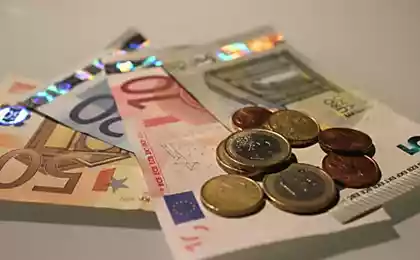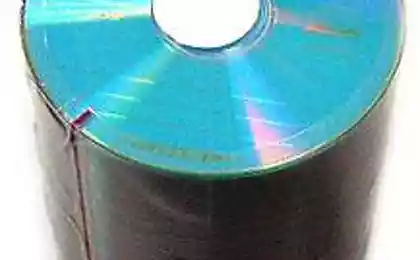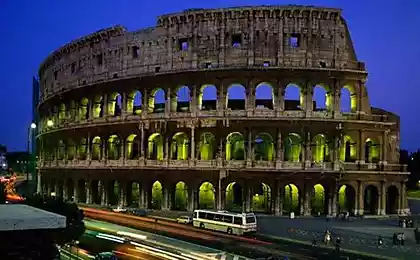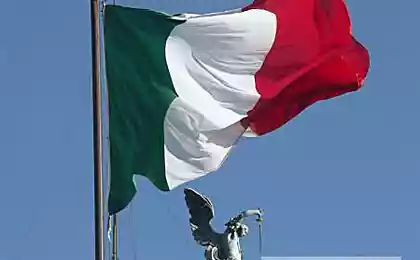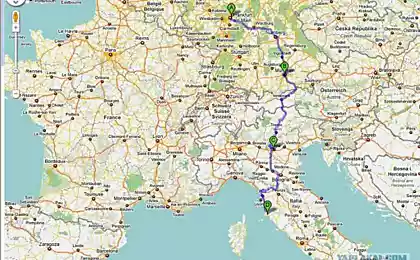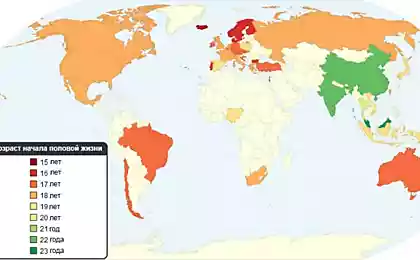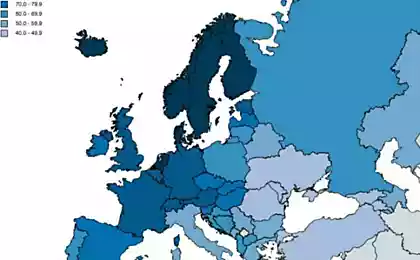282
How to choose a real wine for 5 euros in Italy
Italy is rightfully famous for its wines: the nuances of the local climate and landscape allow you to grow grapes on the Apennines for every taste. Therefore, vini italiani is to everyone's taste - both gourmets and simple lovers of this drink. Over the past 25 years, the wine industry in Italy has experienced a revolution. Local winemakers abandoned the use of fertilizers and chemicals, replaced old barrels with new stainless steel boilers and small oak barrels, and prioritized the quality of the drink rather than its quantity. Hard to believe, but back in the 1960s, no one bought red Chianti wine, too sharp, aggressive, sour and unreasonably light. Antinori, San Felice and other local manufacturers have managed to make a difference.
The map of Italian wines covers the entire territory of Bel Paese - from the Alto Adige region to the hot Mediterranean Calabria and the sultry Sardinia and Sicily.
All local wines are carefully classified. The best drinks can boast of the "title" DOCG (Denominazioni di Origine Controllata e Garantita, a name controlled and guaranteed by origin, that is, wine of the highest category) or DOC (Denominazione di Origine Controllata, name controlled by origin, the main brands of wines). Other beverages are given the name IGT (Indicazione Geografica Tipica, classification of regional wines), positively distinguishing wine from the category of dining (vini da tavola), but not claiming the laurels of the drink of the gods. In addition to the classification when choosing a wine, Italian sommeliers are advised to pay attention to the following: • the inscription on the label prodotto ed imbottigliato da, which means “produced and bottled”. It should prefer the inscription imbottigliato da (spilled) and completely ignore the wine with the inscription condizionato da (packaged), typical of cheap drinks in cardboard packages;
• a real, not a plastic cork;
Sale through enoteks, specialized wine cellars with optimal storage conditions, not supermarkets. In local wine boutiques you can find special calendars, which indicate the best harvest years for different categories of wines.
The most "rich" for wines of the highest categories of DOCG and DOC Italian regions are undoubtedly Piedmont, Veneto and Tuscany. Other wine regions of the country produce excellent IGT wines. What is the secret of such geography? As a rule, the most valuable wines are made from a typical grape variety for each individual region.
Therefore, the uniqueness, recognizable “character”, which cannot be reproduced outside the Bel Paese, and distinguishes the local wines from others.
The taste of real Italian Chianti, Barolo, Barbaresco, Dolcetto or Rifosco cannot be repeated from grapes grown not on fertile native soil. And if Cabernet Sauvignon and Pinot Noir are successfully produced in France, in the United States, and in Italy, then native Italian wines – like local cuisine – are extremely “tied” to their native soil. In the latest issue of the Guida dei Vini of the Espresso newspaper, Guida dei Vini ranked the best drinks in each of the regions of the country with the best combination of price and quality (from 5 to 15 euros per bottle).
So, what and where to choose?
Valle d'Aosta: white Blanc de Morgex et de la Salle 2012 Pavese Ermes with juicy fruit bouquet - excellent for fish, white meats and cheeses
Piedmont: red Dogliani Sorì dij But 2012 Anna Maria Abbona with a pronounced aroma of raspberries and cherries from the Dolcetto grape variety cultivated in Piedmont since the Middle Ages
Liguria: refreshing white Riviera L.di P. Pigato Cycnus 2012 Poggio dei Gorleri with a mild fruity flavour
Lombardy: White Riesling 2012 Monsupello with a bouquet of floral, fruity, herbal notes and spices
Trentino: red Lagrein Merlot Vigna e Vino 2012 Balter Nicola moderately fruity and spicy
Alto Adige: White Alto Adige Pinot Bianco Plattenriegl 2012 Prod. Cornaiano, delicate, refreshing. Ideal for both snacks and fish dishes, and for aperitifs
Veneto: white young Custoza 2012 Villa Medici with a delicate aroma of exotic fruits
Friuli-Venezia Giulia: red Grave Refosco dal peduncolo rosso 2011 Vigneti Le Monde ruby color with purple overflows, aristocratic and harmonious. Especially wins when serving to baked meat and game
Emilia-Romagna: dry white Colli Bolognesi Pignoletto Superiore 2012 Isola with notes of exotic fruits and pineapple, as well as sage and boxwood
Tuscany: delicate red Rosso di Montalcino 2011 Pian delle Querci with notes of barley and plum
Verdicchio dei Castelli di Jesi di Gino 2012 San Lorenzo is a real fruit and flower triumph
Umbria: white Colli Martani Grechetto 2012 Di Filippo Italo with rich taste and pleasant fruit bouquet
Lazio: dry ruby-red Cesanese del Piglio Hyperius 2012 Emme with aroma of flowers and spices and velvet taste, perfectly combined with sausages, pasta with meat sauce and game
Abruzzo and Molise: white Trebbiano d'Abruzzo Fonte Cupa 2012 Montori Camillo with the subtle smell of flowers and apples typical of this vineyard. Ideal as an aperitif and accompaniment to fish dishes
Campaign: white Falanghina 2012 Tenuta Ponte with marvelous aroma and balanced taste
Apulia: Red structured Castel del Monte Rupìcolo 2011 Rivera with rich taste
Basilicata: Red, intriguing, elegant and warming Aglianico del Vulture Terra dei Fuochi 2011 Carbone
Calabria: red Cirò Rosso Cl. Sup. Riserva 2010 Caparra & Siciliani is perfect for meat dishes. Experts advise to open the bottle a few hours before serving to the table
Sicily: white Etna Bianco Superiore 2012 Barone di Villagrande with apple and hawthorn aroma and refreshing, harmonious taste
Sardinia: dry white, perfectly structured Vermentino di Gallura Giogantinu Sup. 2012 C. S. del Giogantinu with elegant aftertaste
For foodies and real connoisseurs of wine, the same guide advises to pay attention to the real “pearls” of Italian winemaking, awarded the highest ratings in 2014:
Red Moscato di Pantelleria 2009 by Ferrandes, Barbaresco Crichët Pajé 2004 Roagna and Barolo Vigna Rionda 2007 by Massolino
Two more Barolo wines, Monfortino 2006 di Giacomo Conterno and Monprivato 2008 di Giuseppe by Mascarello & Figlio, Feldmarschall 2011 di Tiefenbrunner and Trebbiano d’Abruzzo 2011 by Emidio Pepe.
Wine from Trentino Riserva Lunelli 2006 by Ferrari, named the best sparkling 2014
Special attention should be paid to Italian dessert wines that are not included in the classification. Creating a balanced refreshing but sweet drink is the pinnacle of winemaking. To make sure of this, you should definitely try the so-called Italian holy wine, vin santo, which, depending on the manufacturer, can vary in density and sugar levels. In Tuscany, vin santo is often served to cantuccini, a typical local almond biscuit that is dipped in a slightly viscous, sweet drink of a rich golden color. In the south of the country, Pantelleria also produces excellent dessert wines.
And finally, advice: do not equate price and quality. Enterprising Italian restaurateurs have long noticed that tourists from Russia without looking order the most expensive of the wine list drinks. Therefore, in many resorts, truly valuable and popular wines occupy a modest place in the middle of the wine list, and among the most expensive are very mediocre drinks. Many local manufacturers are reluctant to invest in advertising – hence the low price with excellent quality. DOC, DOCG and IGT marks on bottles will guarantee the right choice. When you are in Italy, be sure to pay tribute to the famous local wines, because, as the local saying goes, buon vino fa buon sangue, “good wine heals the blood.” In vino veritas!
Source: domashniy.ru/
The map of Italian wines covers the entire territory of Bel Paese - from the Alto Adige region to the hot Mediterranean Calabria and the sultry Sardinia and Sicily.
All local wines are carefully classified. The best drinks can boast of the "title" DOCG (Denominazioni di Origine Controllata e Garantita, a name controlled and guaranteed by origin, that is, wine of the highest category) or DOC (Denominazione di Origine Controllata, name controlled by origin, the main brands of wines). Other beverages are given the name IGT (Indicazione Geografica Tipica, classification of regional wines), positively distinguishing wine from the category of dining (vini da tavola), but not claiming the laurels of the drink of the gods. In addition to the classification when choosing a wine, Italian sommeliers are advised to pay attention to the following: • the inscription on the label prodotto ed imbottigliato da, which means “produced and bottled”. It should prefer the inscription imbottigliato da (spilled) and completely ignore the wine with the inscription condizionato da (packaged), typical of cheap drinks in cardboard packages;
• a real, not a plastic cork;
Sale through enoteks, specialized wine cellars with optimal storage conditions, not supermarkets. In local wine boutiques you can find special calendars, which indicate the best harvest years for different categories of wines.
The most "rich" for wines of the highest categories of DOCG and DOC Italian regions are undoubtedly Piedmont, Veneto and Tuscany. Other wine regions of the country produce excellent IGT wines. What is the secret of such geography? As a rule, the most valuable wines are made from a typical grape variety for each individual region.
Therefore, the uniqueness, recognizable “character”, which cannot be reproduced outside the Bel Paese, and distinguishes the local wines from others.
The taste of real Italian Chianti, Barolo, Barbaresco, Dolcetto or Rifosco cannot be repeated from grapes grown not on fertile native soil. And if Cabernet Sauvignon and Pinot Noir are successfully produced in France, in the United States, and in Italy, then native Italian wines – like local cuisine – are extremely “tied” to their native soil. In the latest issue of the Guida dei Vini of the Espresso newspaper, Guida dei Vini ranked the best drinks in each of the regions of the country with the best combination of price and quality (from 5 to 15 euros per bottle).
So, what and where to choose?
Valle d'Aosta: white Blanc de Morgex et de la Salle 2012 Pavese Ermes with juicy fruit bouquet - excellent for fish, white meats and cheeses
Piedmont: red Dogliani Sorì dij But 2012 Anna Maria Abbona with a pronounced aroma of raspberries and cherries from the Dolcetto grape variety cultivated in Piedmont since the Middle Ages
Liguria: refreshing white Riviera L.di P. Pigato Cycnus 2012 Poggio dei Gorleri with a mild fruity flavour
Lombardy: White Riesling 2012 Monsupello with a bouquet of floral, fruity, herbal notes and spices
Trentino: red Lagrein Merlot Vigna e Vino 2012 Balter Nicola moderately fruity and spicy
Alto Adige: White Alto Adige Pinot Bianco Plattenriegl 2012 Prod. Cornaiano, delicate, refreshing. Ideal for both snacks and fish dishes, and for aperitifs
Veneto: white young Custoza 2012 Villa Medici with a delicate aroma of exotic fruits
Friuli-Venezia Giulia: red Grave Refosco dal peduncolo rosso 2011 Vigneti Le Monde ruby color with purple overflows, aristocratic and harmonious. Especially wins when serving to baked meat and game
Emilia-Romagna: dry white Colli Bolognesi Pignoletto Superiore 2012 Isola with notes of exotic fruits and pineapple, as well as sage and boxwood
Tuscany: delicate red Rosso di Montalcino 2011 Pian delle Querci with notes of barley and plum
Verdicchio dei Castelli di Jesi di Gino 2012 San Lorenzo is a real fruit and flower triumph
Umbria: white Colli Martani Grechetto 2012 Di Filippo Italo with rich taste and pleasant fruit bouquet
Lazio: dry ruby-red Cesanese del Piglio Hyperius 2012 Emme with aroma of flowers and spices and velvet taste, perfectly combined with sausages, pasta with meat sauce and game
Abruzzo and Molise: white Trebbiano d'Abruzzo Fonte Cupa 2012 Montori Camillo with the subtle smell of flowers and apples typical of this vineyard. Ideal as an aperitif and accompaniment to fish dishes
Campaign: white Falanghina 2012 Tenuta Ponte with marvelous aroma and balanced taste
Apulia: Red structured Castel del Monte Rupìcolo 2011 Rivera with rich taste
Basilicata: Red, intriguing, elegant and warming Aglianico del Vulture Terra dei Fuochi 2011 Carbone
Calabria: red Cirò Rosso Cl. Sup. Riserva 2010 Caparra & Siciliani is perfect for meat dishes. Experts advise to open the bottle a few hours before serving to the table
Sicily: white Etna Bianco Superiore 2012 Barone di Villagrande with apple and hawthorn aroma and refreshing, harmonious taste
Sardinia: dry white, perfectly structured Vermentino di Gallura Giogantinu Sup. 2012 C. S. del Giogantinu with elegant aftertaste
For foodies and real connoisseurs of wine, the same guide advises to pay attention to the real “pearls” of Italian winemaking, awarded the highest ratings in 2014:
Red Moscato di Pantelleria 2009 by Ferrandes, Barbaresco Crichët Pajé 2004 Roagna and Barolo Vigna Rionda 2007 by Massolino
Two more Barolo wines, Monfortino 2006 di Giacomo Conterno and Monprivato 2008 di Giuseppe by Mascarello & Figlio, Feldmarschall 2011 di Tiefenbrunner and Trebbiano d’Abruzzo 2011 by Emidio Pepe.
Wine from Trentino Riserva Lunelli 2006 by Ferrari, named the best sparkling 2014
Special attention should be paid to Italian dessert wines that are not included in the classification. Creating a balanced refreshing but sweet drink is the pinnacle of winemaking. To make sure of this, you should definitely try the so-called Italian holy wine, vin santo, which, depending on the manufacturer, can vary in density and sugar levels. In Tuscany, vin santo is often served to cantuccini, a typical local almond biscuit that is dipped in a slightly viscous, sweet drink of a rich golden color. In the south of the country, Pantelleria also produces excellent dessert wines.
And finally, advice: do not equate price and quality. Enterprising Italian restaurateurs have long noticed that tourists from Russia without looking order the most expensive of the wine list drinks. Therefore, in many resorts, truly valuable and popular wines occupy a modest place in the middle of the wine list, and among the most expensive are very mediocre drinks. Many local manufacturers are reluctant to invest in advertising – hence the low price with excellent quality. DOC, DOCG and IGT marks on bottles will guarantee the right choice. When you are in Italy, be sure to pay tribute to the famous local wines, because, as the local saying goes, buon vino fa buon sangue, “good wine heals the blood.” In vino veritas!
Source: domashniy.ru/


